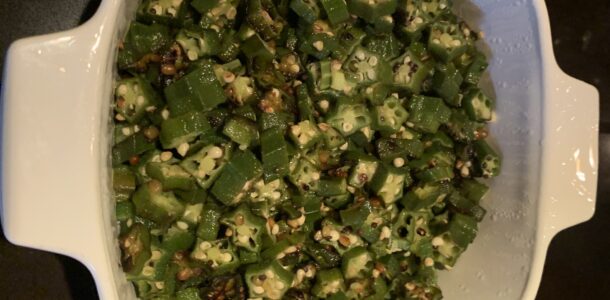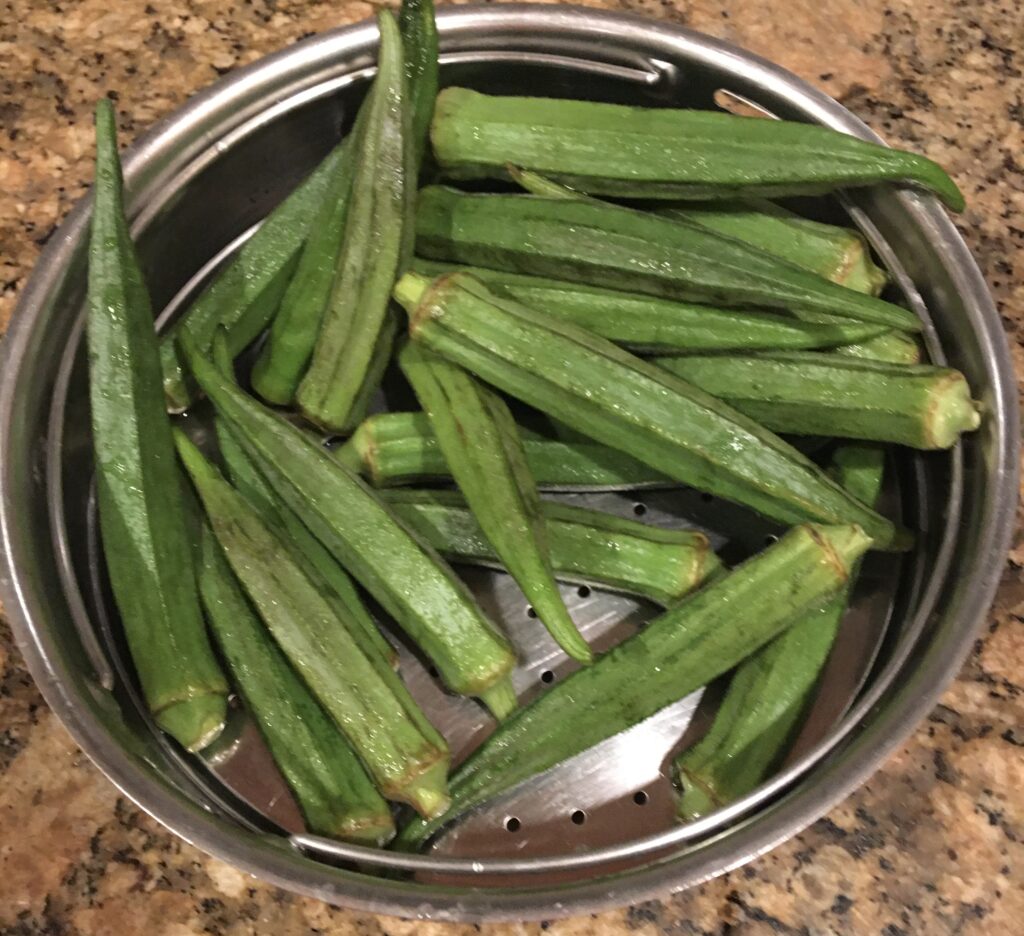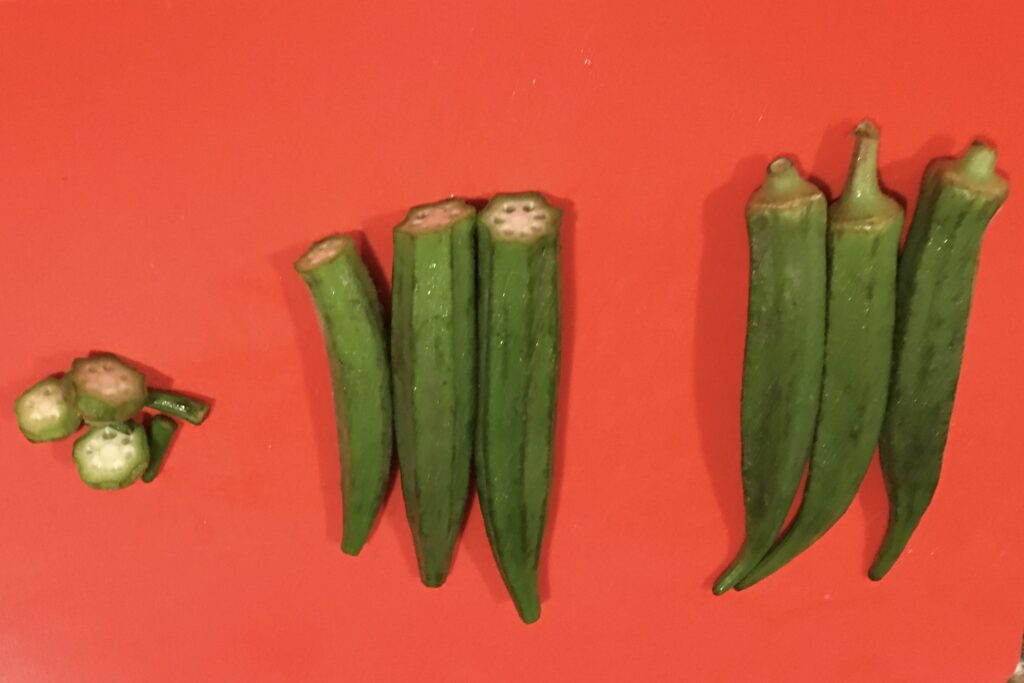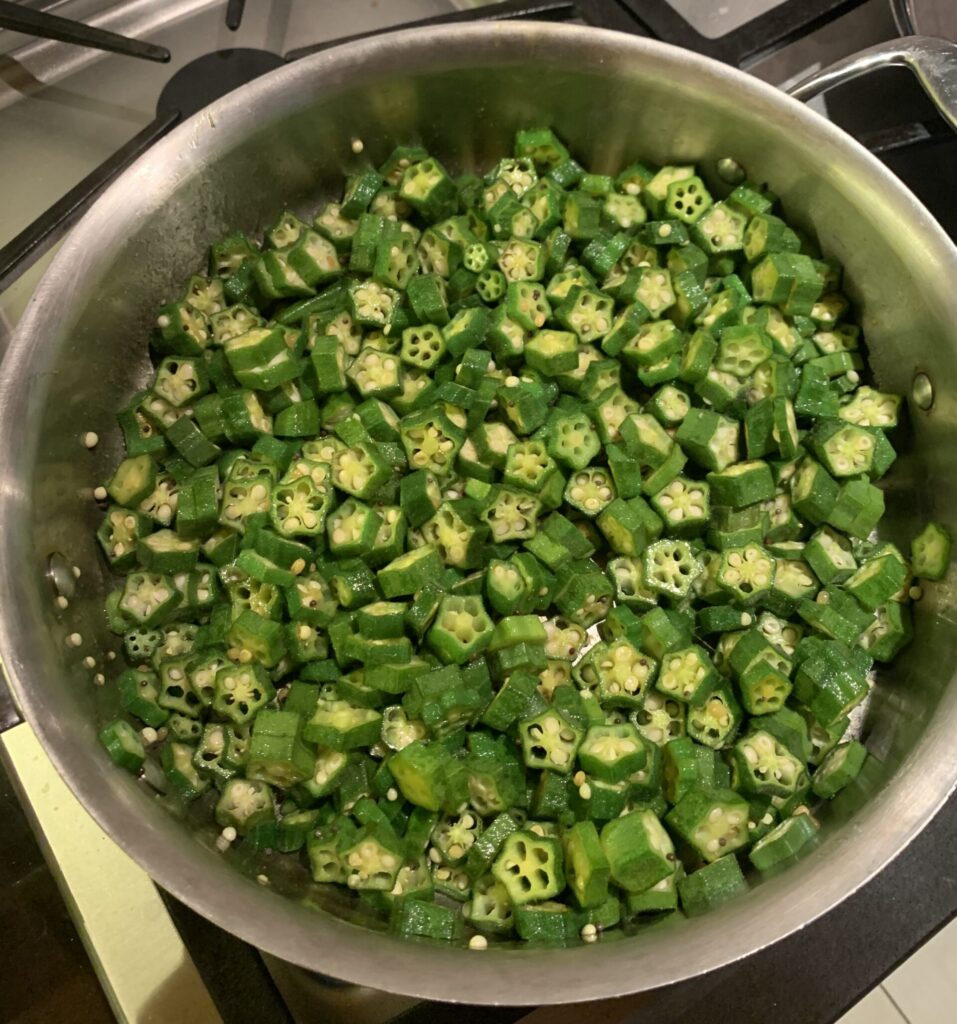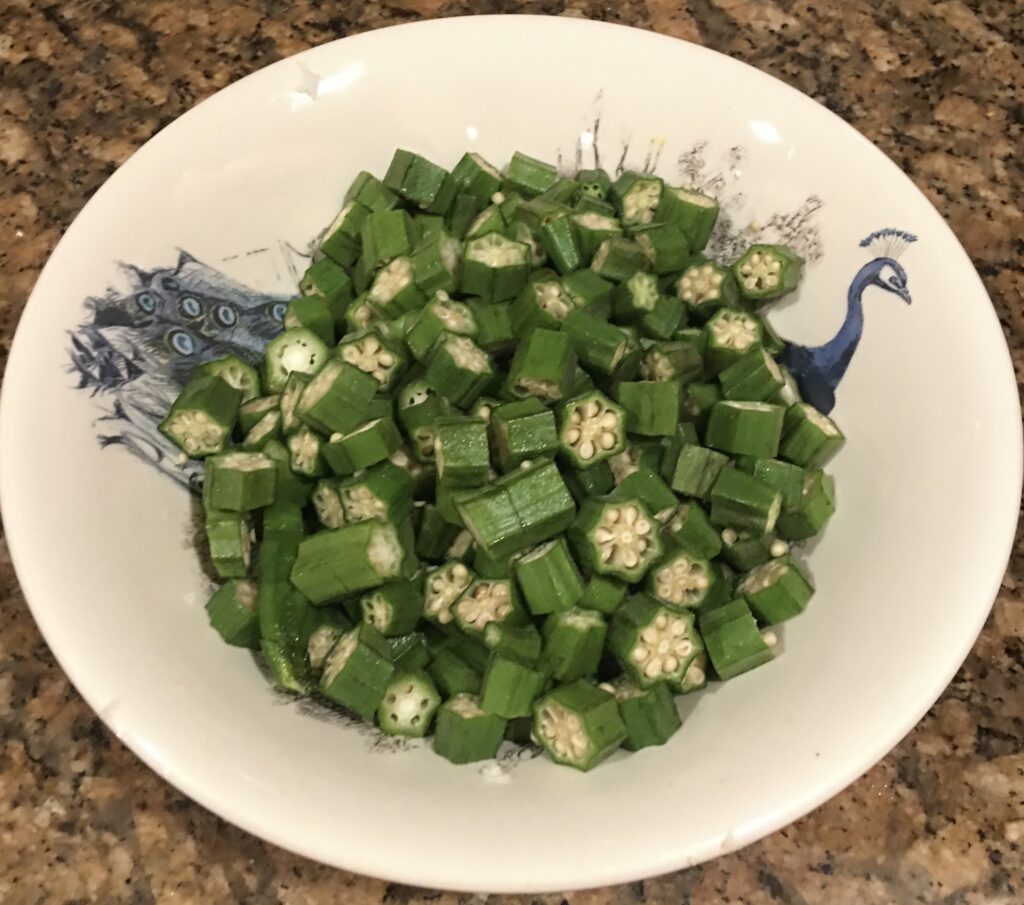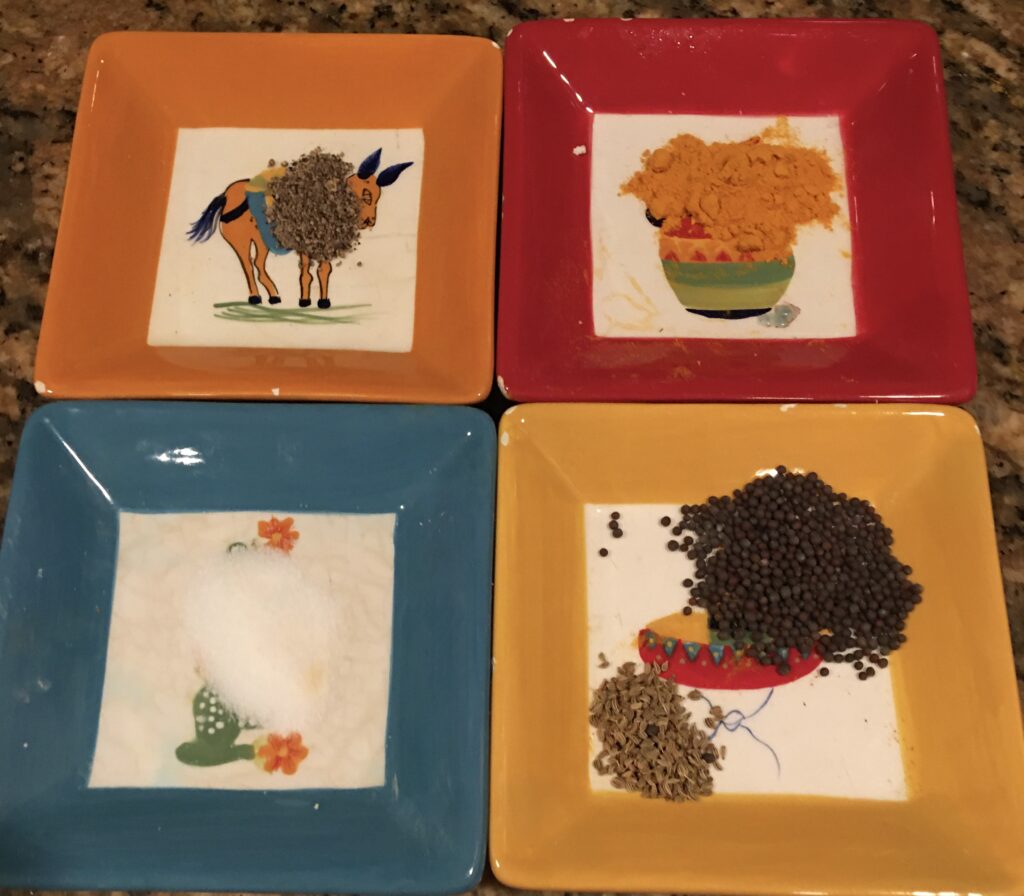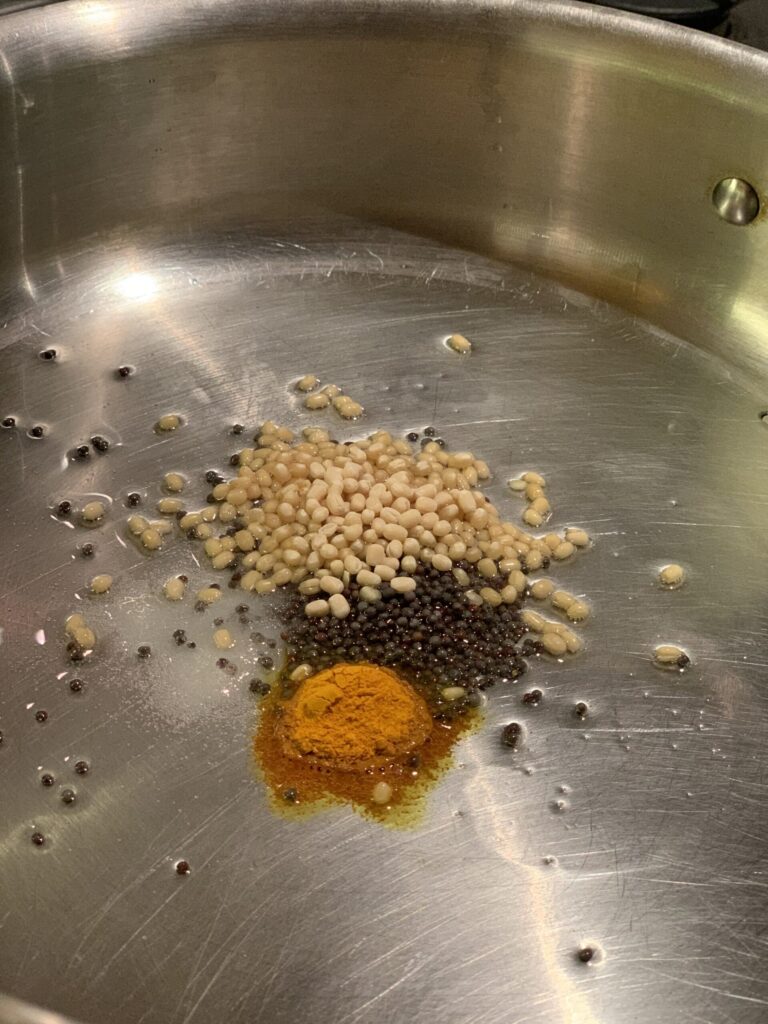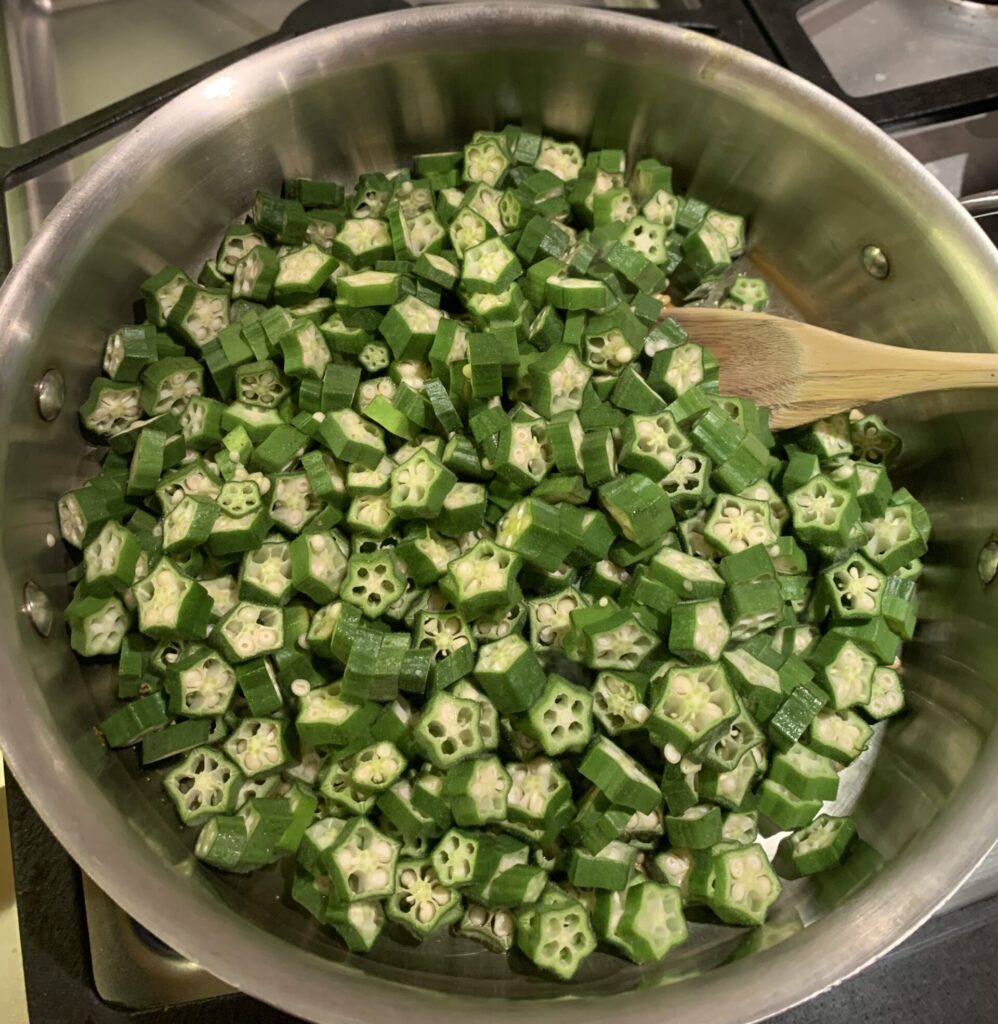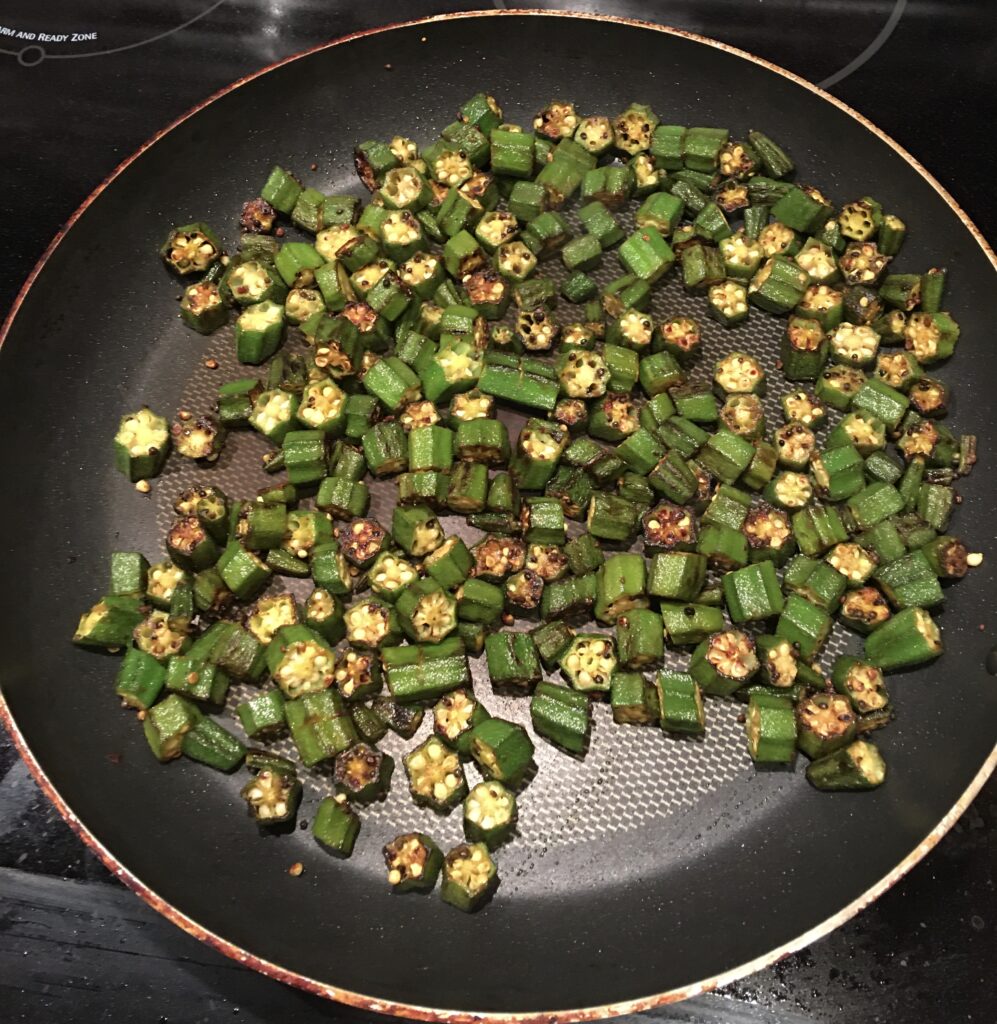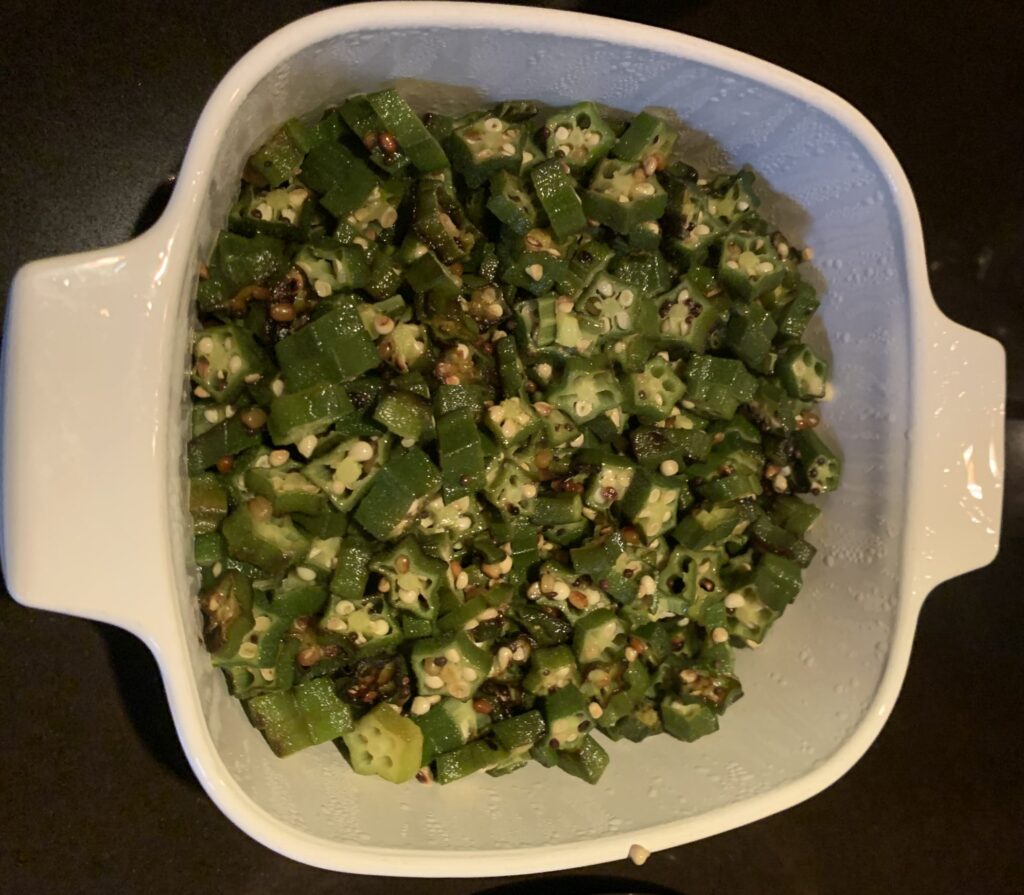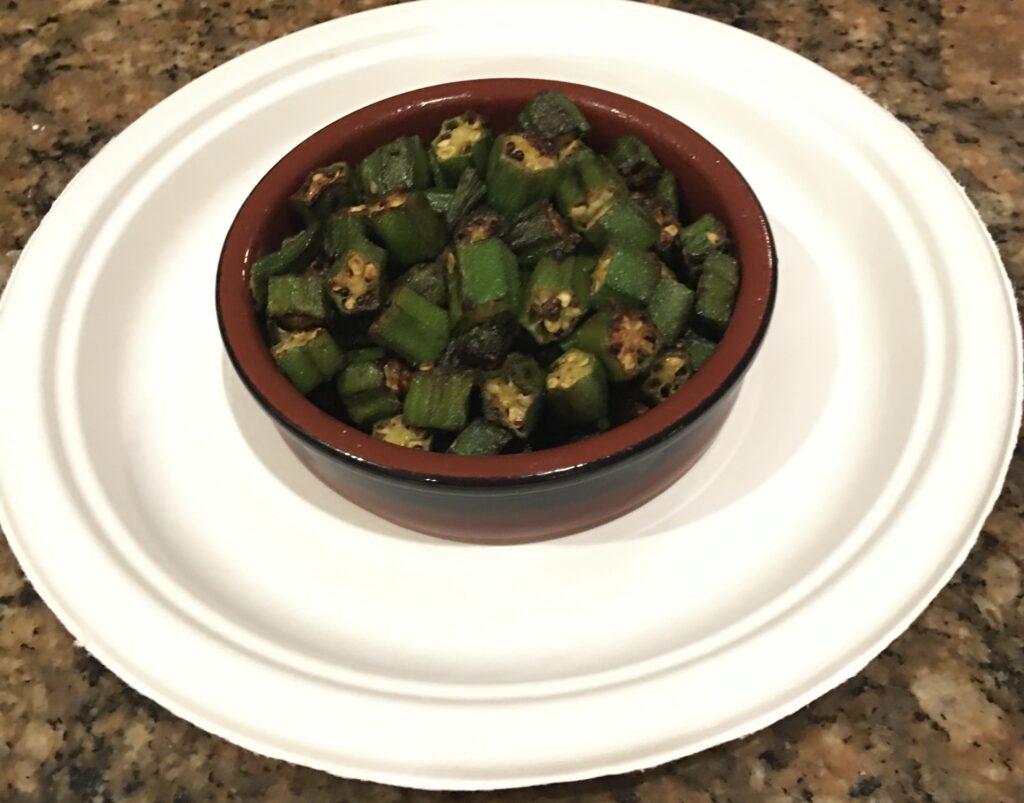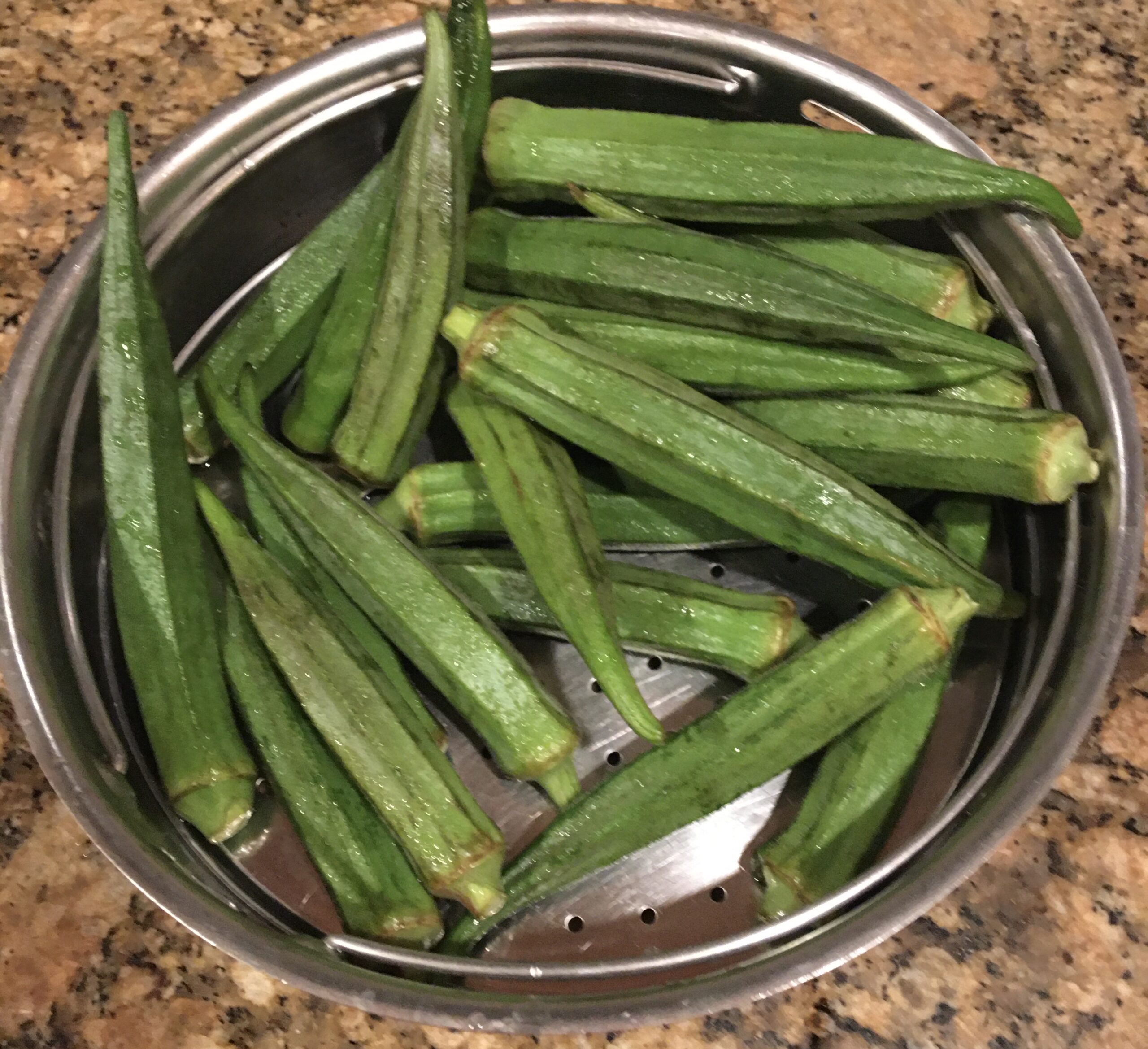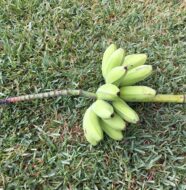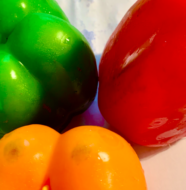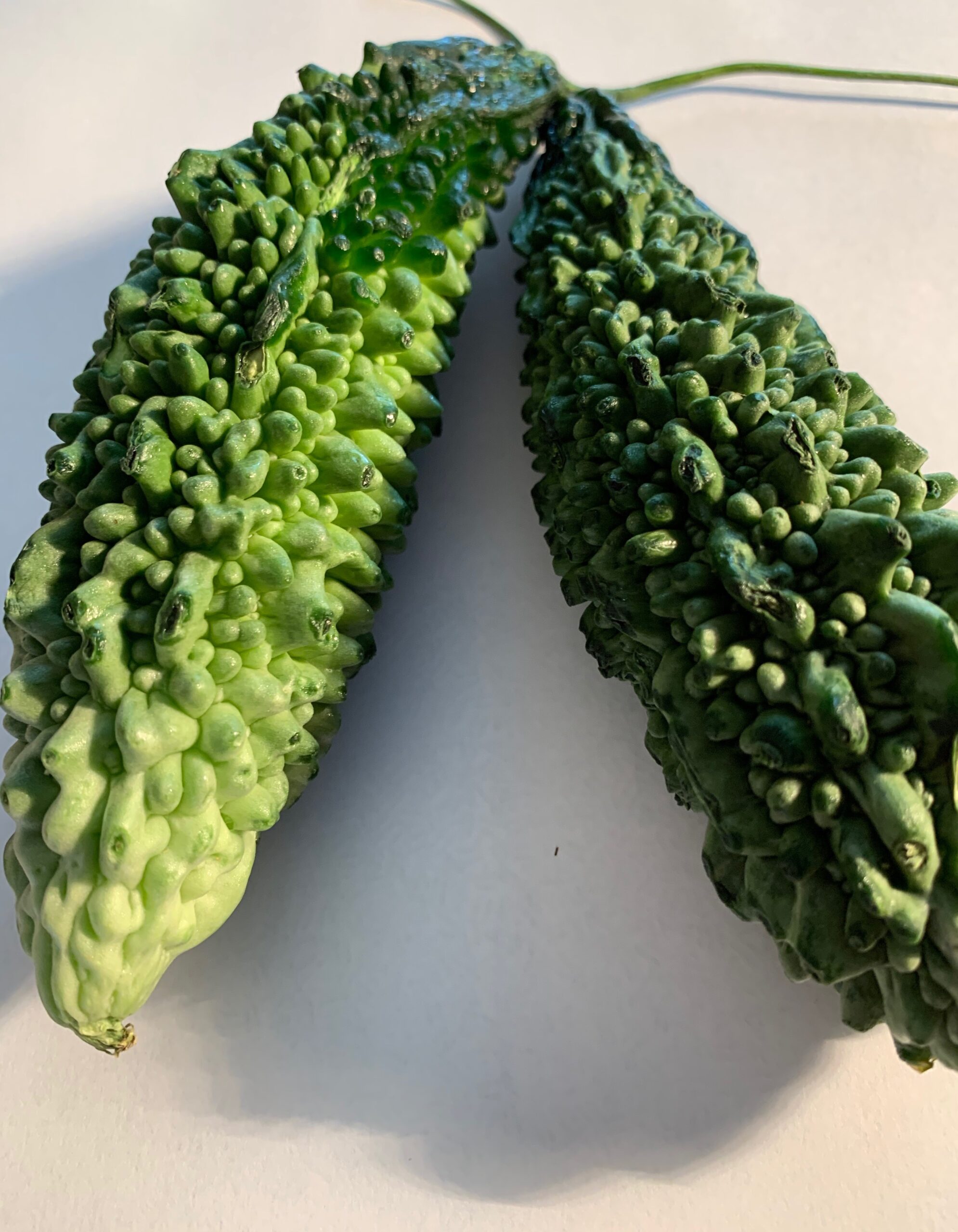Okra has a very high amount of Vitamin A that helps boost vision. With the addition of okra in the diet, you can prevent and protect eyesight, including macular degeneration and cataracts. In India children are encouraged to eat okra, as it is believed to activate memory cells, to enable faster processing of computation skills. In this recipe, okra is cut and sautéed in oil with spices S.Indian style or with onion and tomato N. Indian style.
Okra has soluble fiber that dissolves in water as a slimy goo when boiled. The sliminess can be reduced by stir-frying on high heat or cooking in a soup or stew, where the fiber dissolves and becomes a thickening agent. The slime factor is also cut down by using a souring agent like lime juice, vinegar, tomatoes, tamarind, or buttermilkBuying & Storage: When buying okra look for firm, brightly colored pods under 4″ long. Larger pods may be tough and fibrous. Avoid picking those that are dull in color, limp or blemished. Refrigerate okra in a plastic bag for up to 3 days. Do not wash okra until ready to cook. If you are not going to use okra for a few days freeze them after blanching in boiling water for 3-4 min. and immersed in an ice bath for 5 min. Then freeze infreezer bags expelling all air from it.
History: Okra, known scientifically as “Abelmoschus esculentus or Hibiscus esculentus” derived its name from the Niger-Congo region in Africa. It is a member of the mallow family related to cotton, hibiscus, and hollyhock. It originated in Ethiopia and cultivated by ancient Egyptians by the 12th century. Its cultivation spread to North Africa and the Middle East. Okra came to the Caribbean in the 1700s probably brought by slaves from West Africa. and Introduced to Western Europe soon after. In Louisiana, the creoles learned from the slaves the use of okra to thicken soups and it is now essential in the stew “Creole Gumbo”
Story: The soluble fiber in okra converts to mucus to form a transparent gel-like substance due to the soluble fiber dissolving in water. The gel thickens stews like Gumbo in the New Orleans Cajun-style okra dish (originally African) made with onions, celery, tomatoes, and spices bay and thyme leaves, Cajun seasoning blend (Tony Chachere’s), and hot pepper sauce (Tabasco).
Okra Recipes
Okra can be prepared in many ways: braising, baking, breading & frying. In the Indian style of making okra is sautéed, stuffed, cooked in tamarind sauce mixed with yogurt as a salad. It can also be pickled, dehydrated, sun-dried & preserved for use during the rainy season like sun-dried tomatoes.
Okra Yogurt Salad (Bhendi Raitha)
Okra in Tamarind Sauce (Vendaikai Sambhar)
Okra Sauté (Vendaikai Porial )
Stuffed Okra (Bhara Bhendi)
Sun dried Okra (Vendaikai Vatral)
Nutrition Facts of Okra (Abelmoschus esculentus) 100g raw
| GI =20; GL=2 Water 92.6 % |
Minerals | Vitamins |
| Energy 33 cal – 1.5 % | Sodium 8mg – 0.5% | Folates 88 mug – 22% |
| Carb 7.03g- 5.4% | Potassium 303mg – 6% | Niacin 1.0mg – 6% |
| Protein 2g -4% | Calcium 81mg – 8% | Pantothenic acid 0.245mg – 5% |
| Fat 0.1g – 0.5% | Copper 0.094mg – 10% | Pyridoxine 0.215mg – 16.5% |
| Cholesterol 0mg – 0% | Iron 0.8mg – 10% | Riboflavin 0.06mg – 4.5% |
| Dietary Fiber 3.2g – 9% | Magnesium 57mg – 14% | Thiamin 0.20 mg – 17% |
| Manganese 0.99mg – 43% | Vitamin C 21.1mg – 36% | |
| Carotene Beta 225 mug | Phosphorous 63MG – 9% | Vitamin A 375IU – 12.5% |
| Crypto xanthin 0 mug | Selenium0.7mug – 1% | Vitamin E 0.36mg – 2.5% |
| Lutein -zeaxanthin 516 mug | Zinc 0.6mg – 5.5% | Vitamin K 55 mug – 44% |
Health Benefits of Okra
- Okra can help lower cholesterol levels: The high fiber content in okra has bile reducing property. As the bile is reduced cholesterol needs to replace what is lost. In turn, cholesterol levels decrease, since it has been utilized for another purpose.
- Okra may help prevent Migraines:100g cooked okra has 36 mg – 9% RDA Magnesium which makes it easier to meet the goal for its intake – a key factor in preventing migraines. The mucus forming fiber in okra retains water keeping you hydrated – another condition needed to prevent migraines.
- Okra can improve cardiovascular health: Okra powder is capable of absorbing cholesterol. It helps to improve the ratio of HDL to LDL cholesterol. Studies have shown that okra is also useful in lowering high triglyceride levels. Regular okra consumption reduces the risk of dangerous blockages of arteries.
- Okra assists in maintaining healthy energy levels: Okra encourages the storage of glycogen in the liver, so the body can continue to draw energy from the reserve.
Spice Power
- Mustard seeds give relief from respiratory disorders. They are a wonderful decongestant and expectorant which helps in clearing the mucus in the air passage.
- Turmeric powder helps to detoxify the body, boosts cognitive abilities, aids in reducing stress and depression.some research shows that taking turmeric extracts can reduce pain and improve the function of people with osteoarthritis equivalent to ibuprofen.
- Pepper powder: Anti-tumor properties Antioxidant Piperine in it prevents the damage caused by free radicals; it also exhibits anti-tumor activities for breast, colorectal, and prostate cancer with more research going on.
- Coriander powder minimizes bad cholesterol without affecting levels of good cholesterol, thus preventing heart disease. Nutrients like oleic, linoleic, palmitic, ascorbic, and stearic acid are very effective in controlling the cholesterol levels in the blood.
- Cumin powder regulates digestion. Being a carminative, it relieves us from gas troubles, promotes digestion, and soothes stomach aches. This is due to the presence of magnesium, sodium. and essential oils like Cuminaldehyde, which activates the salivary glands in the mouth to facilitate the primary digestion of food. Thymol another compound present in cumin stimulates the glands that secrete acids, bile, and enzymes that are responsible for the complete digestion of the food in the stomach and intestines.
Method to cook Okra Sauté
- Method I South Indian style
- Wash fresh okra and wipe with a paper towel. Snip the top and bottom.
- Cut into 1″ slices; okra pieces may stick to the knife, separate by hand.
- (1 lb. okra yields 21/2 cups chopped okra pieces.) (5 min.)
- Cook cut okra in a microwave with spices and buttermilk. (5 min.)
- Heat oil in a nonstick frying pan; add mustard seeds,urad lentils salt, and turmeric.
- When seeds splutter and sound subsides, add cooked okra.
- Sauté on low heat until okra is glassy in appearance. (5 min.)
- Alternate north Indian method with onions & tomatoes:
- Fresh or frozen okra can be sautéed in a nonstick frying pan or wok.
- Cut okra, onion, and tomatoes. (5 min.)
- Heat oil in frying pan, add spices; add onions when mustard seeds pop.
- Sauté onions until translucent; add tomatoes, sauté untill oil floats. (4 min.)
- Add cut / frozen okra and vinegar; sauté until okra is shiny.
- Continue to stir intermittently, until okra is soft.(6 min.)
Serve Vendaikai Porial/ Bhendi Subzee with Quinoa, Lemon / coconut rice, Pasta, Bread rolls or Chapatis.
TIPS
To prevent okra from sticking to the knife during cutting, rub oil on the blade before
Time Saver Use Frozen cut okra to save on cutting time
Variation: Add 1/2 tsp. tamarind paste to the okra for a tangy taste
The buttermilk / vinegar helps prevent the okra from sticking together while cooking
WHOLE SPICES CORIANDER , CUMIN, & PEPPER CAN BE GROUND TO KEEP FRESH

